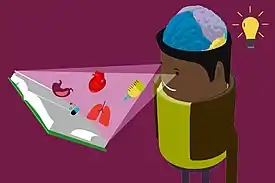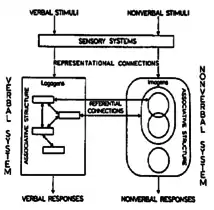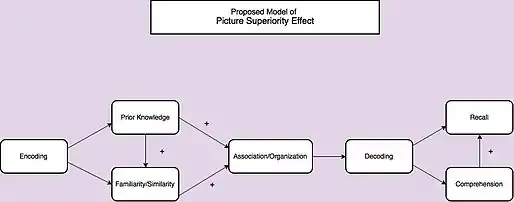Picture superiority effect
The picture superiority effect refers to the phenomenon in which pictures and images are more likely to be remembered than are words.[2][3][4][5][6][7] This effect has been demonstrated in numerous experiments using different methods. It is based on the notion that "human memory is extremely sensitive to the symbolic modality of presentation of event information".[8] Explanations for the picture superiority effect are not concrete and are still being debated.

History
Allan Paivio's dual-coding theory is a basis of picture superiority effect. Paivio claims that pictures have advantages over words with regards to coding and retrieval of stored memory because pictures are coded more easily and can be retrieved from symbolic mode, while the dual coding process using words is more difficult for both coding and retrieval. Another explanation of the higher recall in picture superiority is the higher familiarity or frequency of pictured objects (Asch & Ebenholtz, 1962).[1] According to dual-coding theory (1971, 1986), memory exists either (or both) verbally or through imagery. Concrete concepts presented as pictures are encoded into both systems; however, abstract concepts are recorded only verbally. In psychology, the effect has implications for salience in attribution theory as well as the availability heuristic. It is also relevant to advertising and user interface design.
Related theories
Paivio – Dual coding theory
Picture stimuli have an advantage over word stimuli because they are dually encoded; they generate a verbal and image code, whereas word stimuli only generate a verbal code. Pictures are likely to generate a verbal label, whereas words are not likely to generate image labels.[4]
Nelson – Sensory semantic theory
Pictures hold two encoding advantages over words. Pictures are perceptually more distinct from one another than are words, thus increasing their chance for retrieval. In experiments when similarity among pictures was high, no picture superiority effect was present. Pictures are also believed to assess meaning more directly than words. Levels of processing theory apply when words and pictures are compared under semantic study instructions (rate the pleasantness of each item), recall is very similar for pictures and words, as both were encoded at deeper levels.[4]
Picture superiority results from superior encoding for pictures over words, which facilitates greater recollection of pictures.[2]
Weldon and Roediger-transfer appropriate processing theories
Greater overlap of processing at study and test result in increased performance. TAP accounts for picture superiority by an interaction of encoding and retrieval. If items are encoded during a semantic task, performance should be higher for a memory test that relies on concepts related to the items for retrieval than a test that relies on perceptual features.[4]
Evidence
This effect has been shown to occur in recognition memory tasks, where items studied as pictures are better remembered than items studied as words, even when targets are presented as words during the test phase.[5] Whether the picture superiority effect influences the familiarity and/or recollection processes, according to the dual-process models, thought to underlie recognition memory is not clear.[2]
In experiments of associative recognition memory, participants studied random concrete word pairs, and line drawing pairs. They had to discriminate between intact and rearranged pairs at test. The picture superiority effect continued to express a strong effect with a greater hit rate for intact picture pairs. This further supports encoding theories[9] More recent research in associative recognition shows support that semantic meaning of nameable pictures is activated faster than that of words, allowing for more meaningful associations between items depicted as pictures to be generated.[10]
Pictures have distinctive features that enable to distinguish pictures from words and such discriminability increase memory ability in comparison with verbal cues (Jenkins, Neale & Deno, 19[11] 67). Picture Superiority effect was also evident for memory recall during semantic procession (Childers & Houston, 1984[12]). Moreover, pictures in pairs or group were better organized in our memory than words thus resulting in superiority in recall (Pavio & Csapo, 1973[13]). The picture superiority effect is also present in spatial memory, where locations of items and photographs were remembered better than locations of words.[14]
Critique
The advantage of pictures over words is only evident when visual similarity is a reliable cue; because it takes longer to understand pictures than words (Snodgrass & McCullough, 1986[15]). Pictures are only superior to words for list learning because differentiation is easier for pictures (Dominowski & Gadlin, 1968[16]). In reverse picture superiority it was observed that learning was much slower when the responses were pictures (Postman, 1978[17]). Words produced a faster response than pictures and pictures did not have an advantages of having easier access to semantic memory or superior effect over words for dual-coding theory (Amrhein, McDaniel & Waddill 2002[18]). Similarly, studies where response time deadlines have been implemented, the reverse superiority effect was reported. This is related to the dual-process model of familiarity and recollection. When deadlines for the response were short, the process of familiarity was present, along with an increased tendency to recall words over pictures. When response deadlines were longer, the process of recollection was being utilized, and a strong picture superiority effect was present.[19] In addition, equivalent response time was reported for pictures and words for intelligence comparison (Paivio & Marschark, 1980[20]). Contrary to the assumption that pictures have faster access to the same semantic code than words do; all semantic information is stored in a single system. The only difference is that pictures and words access different features of the semantic code (te Linde, 1982[21]).
With age
Across the lifespan, a gradual development of the picture superiority effect is evident. Some studies have shown that it appears to become more pronounced with age,[5][6] while others have found that this effect is also observed among younger children (Whitehouse, Mayber, Durkin, 2006[6]). However, the major contribution in picture superiority in recognition memory among children was familiarity (Defeyter, Russo & McPartlin, 2009[5]). During childhood, specifically among seven-year-olds, the picture superiority effect is lesser in magnitude than in other age groups.[6] This could be due to the lack of inner speech among younger children supporting the dual coding theory of Paivio. In healthy older adults, the picture superiority effect was found to be greater than it was for younger adults, in comparison to recognition for words, which was disadvantaged for older adults.[22] In that regard, seniors can benefit from using pictorial information to retain textual information (Cherry et al., 2008[23]). While memory for words is impaired for older adults, pictures help restore their impaired memory and function properly (Ally et al., 2008[22]). In addition, older adults have shown the same level of capability for identifying correct items in comparison with young adults when items were accompanied with pictures (Smith, Hunt & Dunlap, 2015). In populations with Alzheimer's disease, and other mild cognitive impairments, the picture superiority effect remains evident.[24] ERP activity indicates that patients with amnesic mild cognitive impairment utilized frontal-lobe based memory processes to support successful recognition for pictures, which was similar to healthy controls, but not for words.[24]
Applications
- Education (language learning): Learners can structure a mental model when processing a picture initially so that no further model construction may be required for subsequent processing of a text. Presenting picture before text is beneficial to students with low prior knowledge (Eitel & Scheiter, 2015[25]). In a similar vein, reading a picture prior to processing textual information improves comprehension levels for students with low prior knowledge (Salmerón, Baccino, Cañas, Madrid, & Fajardo, 2009[26]). Pictures can be more effective than word translation for language learning when individuals are not overconfident in the mnemonic power of pictures (Carpenter & Olson, 2011[27]). If they are overconfident, pictures lose superiority over words.
- Health communication: A study by Ally, Gold and Budson (2009)[7] confirm that picture superiority effect was observed among mild Alzheimer's disease (AD) and amnestic-type mild cognitive impairment (MC). Pictures have a significantly positive effect on four areas of communication: attention, comprehension, recall, and intention/adherence. Health education materials can benefit greatly by adding pictures as pictures can be especially beneficial for people who lack literacy skill (Houts, C.Doak, L.Doak &Loscalzo, 2006[28]). Picture superiority effect can be implemented in creating materials for health communication that inclusion of fearful or disgusting images led to improved recognition memory in comparison with the condition without a presence of image (Leshner, Vultee, Bolls & Moore, 2010[29]).
- Advertising: Percy and Rossiter[30] (1997, p. 295) stated, "The picture is the most important structural element in magazine advertising, for both consumer and business audiences." Visually framed messages were more effective under the condition where the audience was less motivated and had less ability to process information semantically. Visual ads require less exposure than verbal ads for long-term memory effect (Childers & Houston, 1984[12]). The pictorial component in the ad is more likely to be viewed before words, and it generates an expectation for the verbal component of the ad (Houston, Childers & Heckler, 1987[31]). Maximizing the size of pictures regardless of advertising contents will improve attention to the entire advertisement as pictures draw significant attention to baseline in the ads (Pieters & Wedel, 2004[32]).
Proposed model


Direction for future studies
- Clinical setting to evaluate pictures for health communication (Houts, C.Doak, L.Doak &Loscalzo, 2006[28])
- Empirical studies on simplicity of picture for encoding and decoding the pictorial information
See also
References
- Asch, Solomon E.; Ebenholtz, Sheldon M. (1962). "The Principle of Associative Symmetry". Proceedings of the American Philosophical Society. 106 (2): 135–163. JSTOR 985378.
- Curran, T.; Doyle, J. (2011). "Picture superiority doubly dissociates the ERP correlates of recollection and familiarity". Journal of Cognitive Neuroscience. 23 (5): 1247–1262. doi:10.1162/jocn.2010.21464. PMID 20350169. S2CID 6568038.
- Shepard, R.N. (1967). "Recognition memory for words, sentences, and pictures". Journal of Learning and Verbal Behavior. 6: 156–163. doi:10.1016/s0022-5371(67)80067-7.
- McBride, D. M.; Dosher, B.A. (2002). "A comparison of conscious and automatic memory processes for picture and word stimuli: a process dissociation analysis". Consciousness and Cognition. 11 (3): 423–460. doi:10.1016/s1053-8100(02)00007-7. PMID 12435377. S2CID 2813053.
- Defetyer, M. A.; Russo, R.; McPartlin, P. L. (2009). "The picture superiority effect in recognition memory: a developmental study using the response signal procedure". Cognitive Development. 24 (3): 265–273. doi:10.1016/j.cogdev.2009.05.002.
- Whitehouse, A. J.; Maybery, M.T.; Durkin, K. (2006). "The development of the picture-superiority effect". British Journal of Developmental Psychology. 24 (4): 767–773. doi:10.1348/026151005X74153.
- Ally, B. A.; Gold, C. A.; Budson, A. E. (2009). "The picture superiority effect in patients with Alzheimer's disease and mild cognitive impairment". Neuropsychologia. 47 (2): 595–598. doi:10.1016/j.neuropsychologia.2008.10.010. PMC 2763351. PMID 18992266.
- Yuille, John C. (2014-05-09). Imagery, Memory and Cognition (PLE: Memory): Essays in Honor of Allan Paivio. Psychology Press. ISBN 9781317685470.
- Hockley, W. E. (2008). "The picture superiority effect in associative recognition". Memory & Cognition. 36 (7): 1351–1359. doi:10.3758/MC.36.7.1351. PMID 18927048.
- Hockley, W.E.; Bancroft, T. (2011). "Extensions of the picture superiority effect in associative recognition". Canadian Journal of Experimental Psychology. 65 (4): 236–244. doi:10.1037/a0023796. PMID 21728402.
- Jenkins, Joseph R; Neale, Daniel C; Reno, Stanley L (1967). "Differential memory for picture and word stimuli". Journal of Educational Psychology. 58 (5): 303–307. doi:10.1037/h0025025. PMID 6079075.
- Childers, Terry L; Houston, Michael J (1984). "Conditions for a picture-superiority effect on consumer memory". Journal of Consumer Research. 11 (2): 643. CiteSeerX 10.1.1.486.9741. doi:10.1086/209001.
- Paivio, Allan; Csapo, Kalman (1973). "Picture superiority in free recall: Imagery or dual coding?". Cognitive Psychology. 5 (2): 176–206. doi:10.1016/0010-0285(73)90032-7.
- Cattaneo, Z.; Rosen, M.; Vecchi, T.; Pelz, J. B. (2008). "Monitoring eye movements to investigate the picture superiority effect in spatial memory". Perception. 37 (1): 34–49. doi:10.1068/p5623. PMID 18399246. S2CID 30843136.
- Snodgrass, Joan G; McCullough, Brian (1987). "The role of visual similarity in picture categorisation". Journal of Experimental Psychology: Learning, Memory, and Cognition. 12 (1): 147–154. doi:10.1037/0278-7393.12.1.147. PMID 2949047. S2CID 234873.
- Dominowski, Roger L.; Gadlin, Howard (1968). "Imagery and paired-associate learning". Canadian Journal of Psychology. 22 (5): 336–348. doi:10.1037/h0082774.
- Postman, L. (1978). "Picture-word differences in the acquisition and retention of paired associates". Journal of Experimental Psychology: Human Learning and Memory. 4 (2): 146–57. doi:10.1037/0278-7393.4.2.146. PMID 632757.
- Amrhein, Paul C; McDaniel, Mark; Waddill, Paula (2002). "Revisiting the picture superiority effect in symbolic comparison: Do pictures provide privileged access?". Journal of Experimental Psychology: Learning, Memory, and Cognition. 28 (5): 843–857. doi:10.1037/0278-7393.28.5.843. PMID 12219794.
- Boldini, A.; Russo, R.; Punia, S.; Avons, S. E. (2007). "Reversing picture superiority effect: a speed-accuracy trade-off study of recognition memory". Memory & Cognition. 35 (1): 113–123. doi:10.3758/BF03195948. PMID 17533886.
- Paivio, Allan; Marschark, Marc (1980). "Comparative judgements of animal intelligence and pleasantness". Memory & Cognition. 8: 39–48. doi:10.3758/BF03197550.
- te Linde, John (1982). "Picture-word difference in decision latency: A test of common-coding assumptions". Journal of Experimental Psychology: Learning, Memory, and Cognition. 8 (6): 584–598. doi:10.1037/0278-7393.8.6.584. PMID 6218223.
- Ally, B. A.; Waring, J. D.; Beth, E. H.; McKeever, J. D.; Milberg, W. P.; Budson, A. E. (2008). "Aging memory for pictures: using high-density event-related potentials to understand the effect of aging on the picture superiority effect". Neuropsychologia. 46 (2): 679–689. doi:10.1016/j.neuropsychologia.2007.09.011. PMC 2271145. PMID 17981307.
- Cherry, Katie E; Hawley, Karri S; Jackson, Erin M; Volaufova, Julia; Su, Joseph; Jazwinski, Michal (2008). "Pictorial superiority effects in oldest-old people". Memory. 16 (7): 728–741. doi:10.1080/09658210802215534. PMC 2575043. PMID 18651263.
- Ally, B. A.; McKeever, J. D.; Waring, J. D.; Budson, A. E. (2009). "Preserved frontalmemorial processing for pictures in patients with mild cognitive impairment". Neuropsychologia. 47 (10): 2044–2055. doi:10.1016/j.neuropsychologia.2009.03.015. PMC 2724267. PMID 19467355.
- Eitel, Alexander; Scheiter, Katharina (2015). "Picture or Text First? Explaining Sequence Effects when Learning with Pictures and Text". Educational Psychology Review. 27: 153–180. doi:10.1007/s10648-014-9264-4. S2CID 145364053.
- Salmerón, Ladislao; Baccino, Thierry; Cañas, Jose J; Madrid, Rafael I; Fajardo, Inmaculada (2009). "Do graphical overviews facilitate or hinder comprehension in hyptertext?". Computers & Education. 53 (4): 1308–1319. doi:10.1016/j.compedu.2009.06.013.
- Carpenter, Shana K; Olson, Kellie M (2012). "Are pictures good for learning new vocabulary in a foreign language? Only if you think they are not". Journal of Experimental Psychology: Learning, Memory, and Cognition. 38 (1): 92–101. doi:10.1037/a0024828. PMID 21787105. S2CID 14999915.
- Houts, Peter S.; Doak, Cecilia C.; Doak, Leonard G.; Loscalzo, Matthew J. (2006). "The role of pictures in improving health communication: A review of research on attention, comprehension, recall, and adherence". Patient Education and Counseling. 61 (2): 173–190. doi:10.1016/j.pec.2005.05.004. PMID 16122896.
- Leshner, Glenn; Volte, Fred; Bolls, Paul D; Moore, Jensen (2010). "When a fear appeal isn't just a fear appeal: The effects of graphic anti-tobacco messages". Journal of Broadcasting & Electronic Media. 54 (3): 485–507. doi:10.1080/08838151.2010.498850. S2CID 144001133.
- Percy, Larry; Rossiter, John R (1997). A theory-based approach to pretesting advertising. WD Wells. p. 295.
- Houston, Michael J; Childers, Terry L; Heckler, Susan E (1987). "Picture-word consistency and the elaborative processing of advertisements". Journal of Marketing Research. 24 (4): 359. doi:10.2307/3151383. JSTOR 3151383.
- Pieters, Rik; Wedel, Michel (2004). "Attention Capture and Transfer in Advertising: Brand, Pictorial, and Text-Size Effects". Journal of Marketing. 68 (2): 36–50. doi:10.1509/jmkg.68.2.36.27794. S2CID 15259684.
- Sources
- Nelson, D.L.; Reed, U.S.; Walling, J.R. (1976). "Pictorial superiority effect". Journal of Experimental Psychology: Human Learning & Memory. 2 (5): 523–528. doi:10.1037/0278-7393.2.5.523. PMID 1003125.
- Paivio, A. (1971). Imagery and verbal processes. New York: Holt, Rinehart & Winston.
- Paivio, A. (1986). Mental representations: A dual-coding approach. New York: Oxford University Press.